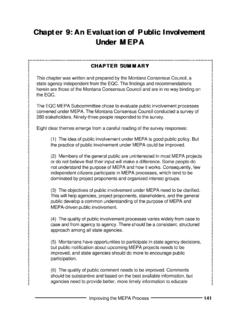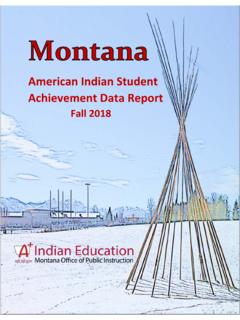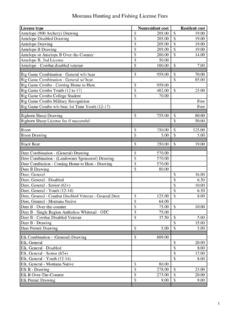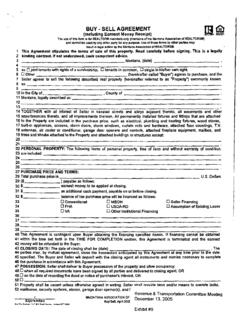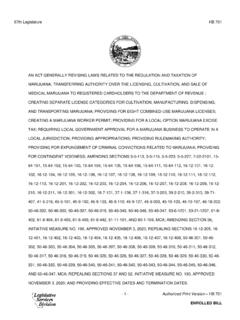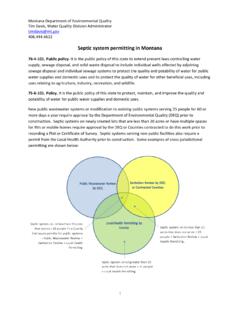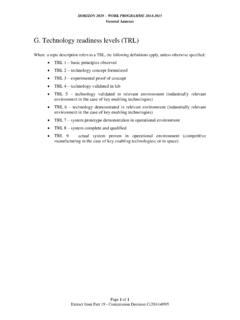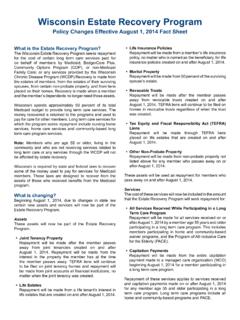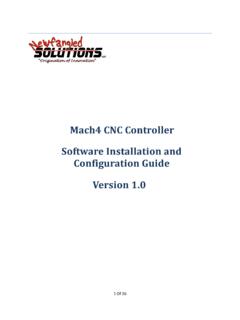Transcription of 2014 Water Rights Handbook - Montana State Legislature
1 April 2014 . This document has been updated to reflect Montana statute and rules as of April 2014 . Montana Department of Natural Legislative Environmental Resources and Conservation Quality Council Box 201601 Box 201704. Helena, MT 59620-1601 Helena, MT 59620-1704. Phone (406) 444-2074 Phone (406) 444-3742. Montana University System Water Center 23 Faculty Court Montana State University-Bozeman Bozeman, MT 59717-2690. Phone (406) 994-6690. Acknowledgment Water Rights in Montana is a compilation of two previous citizen guides discussing Montana Water Rights the Montana Department of Natural Resources and Conservation's Water Rights in Montana and the Environmental Quality Council's and Montana University System Water Center's Wading into Montana Water Rights . We would like to thank the authors of the latter guide, Michelle Bryan and Professor Gerald L.
2 Westesen, for their significant contribution to this publication. i ii Disclaimer Water Rights in Montana should not be used as a legal reference. When in doubt, always refer to the Montana CODE ANNOTATED or the Department of Natural Resources and Conservation ADMINISTRATIVE. RULES OF When making any legal judgments on the adequacy or completeness of procedure, always consult your own legal counsel. 1. Terms that are capitalized and underlined are further defined or explained in the glossary at the end of the publication. iii iv Table of Contents Acknowledgment .. i Disclaimer .. iii Background of Water Rights in Montana .. 1. Montana Water Use 2. Water Rights Administration .. 3. Adjudication of Existing Water Rights .. 4. Historical Evolution .. 4. Who Administers the Adjudication Process?
3 6. How Is the Order of Adjudication Determined?.. 7. How Does the Adjudication Process Work? .. 7. Decrees .. 9. Examination .. 9. Temporary Preliminary Decree .. 9. Preliminary Decree .. 10. Public Notice of the Decree .. 10. Objections .. 10. Hearing .. 10. Resolving Issue Remarks .. 11. Final Decree .. 14. What Is the Current Status of the Adjudication Process? .. 14. Types of Water Rights .. 14. Water Rights Prior to 14. Other Water Rights .. 15. Federal Reserved and Indian Reserved Water Rights .. 15. Status of Water Compacts in Montana .. 16. New Appropriations of Water .. 22. Surface Water .. 22. Ground Water .. 23. Stream Depletion Zones .. 24. Replacement Wells .. 25. Redundant Wells .. 25. Replacement Point of 26. Special Ground Water Circumstances.
4 27. Leasing Water Rights for Road 29. How the Permit System Works .. 29. Temporary Permits .. 35. Interim 36. Changes in Water 36. Temporary Change in Appropriation Water Right .. 38. Marketing for Aquifer Recharge or Mitigation .. 38. Temporary Lease of a Water Right .. 39. Salvaged Water .. 39. Ownership of a Water 40. Water Distribution .. 41. Dispute Resolution and Enforcement .. 42. Water Reservations .. 42. Instream Use and Leasing .. 43. Controlled Ground Water Areas .. 44. Yellowstone Controlled Ground Water Area .. 46. Closure of Highly Appropriated Basins .. 48. Legislative Closures .. 48. Administrative Rule Closures .. 48. Compact Closures .. 50. Sources of 52. DNRC Offices .. 52. Water Resources Regional Offices .. 53. Montana University System Water Center.
5 54. Montana Water 54. Environmental Quality Council Water Policy Interim Committee .. 54. Other Information Sources .. 55. Water Conversion Table .. 55. Water Right Forms and Fees .. 55. Glossary of Terms .. 59. Figures and Tables Claim Examination Flow Chart .. 13. Status of Water Compacts in Montana .. 16. Flowchart of Closed Basin Ground Water Permits .. 28. Flowchart for Permit and Change Applications .. 30. Water Quantity and Water Quality Closures .. 47. Administrative Basin Closures .. 49. Water Right Forms and Fees .. 56. Background of Water Rights in Montana Few elements reach so deeply into the human existence as Water . Our economic endeavors, recreational excursions, and very well-being depend on the quality and abundance of this resource. But who can use Water ?
6 How much can they use? At what time? What uses are legal? Such questions lead into the realm of Water Rights a blend of laws, regulations, and traditions that govern the distribution of Montana 's Water among its many users. Montana waters, in all their varied forms and locations, belong to the State . This ownership, however, exists on behalf of all State citizens. The Montana Constitution explains that: [a]ll surface, underground, flood, and atmospheric waters within the boundaries of the State are the property of the State for the use of its people .. (Article IX, section 3(3)) (emphasis added). Because Montana waters belong to the State , Water Rights holders do not own the Water itself. Instead, they possess a right to use the Water , within State guidelines. Accordingly, Montana law notes: [a] Water right means the right to use Water .
7 (section 85- 2-422, MCA) (emphasis added). Water Rights in Montana are guided by the prior appropriation doctrine, that is, first in time is first in right. A person's right to use a specific quantity of Water depends on when the use of Water began. The first person to use Water from a source established the first right; the second person could establish a right to the leftover Water , and so on. During dry years, the person with the first right has the first chance to use the available Water to fulfill that right. The holder of the second right has the next chance. Water users are limited to the amount of Water that can be beneficially used. In Montana , the term beneficial use means, generally, a use of Water for the benefit of the appropriator, other persons, or the public, including but not limited to agricultural (including stock Water ), domestic, fish and wildlife, industrial, irrigation, mining, municipal, power, and recreational uses.
8 Other beneficial uses include instream flow to benefit fish, AQUIFER. 1. RECHARGE, MITIGATION, or an AQUIFER STORAGE AND RECOVERY. PROJECT. The Water Rights process with all its discrepancies and conflicts was a major topic at the 1972 Montana Constitutional Convention. Policymakers recognized the overwhelming need for improved recordkeeping and regulation. First, the Convention incorporated all past Water Rights into the new Montana Constitution: [a]ll existing Rights to the use of any waters .. are hereby recognized and confirmed (Article IX, section 3(1)). EXISTING Rights included any right originating before July 1, 1973. Whether a use right, DECREED Water RIGHT, or filed right, each was now equally VALID. By recognizing all Rights , the State upheld the prior appropriation doctrine and over 100 years of precedent.
9 To strengthen State supervision, the Convention next charged the Montana Legislature with providing for: .. the administration, control, and regulation of Water Rights and a system of centralized records .. (Article IX, section 3(4)). The Legislature responded by enacting Title 85, chapter 2, MCA. Montana Water Use Act The provisions of Title 85, chapter 2, MCA, commonly referred to as the Montana Water Use Act, were the most comprehensive change in Montana 's Water Rights laws in the State 's history. The Act (effective July 1, 1973) changed the Water Rights administration significantly in a number of ways. 1. All Water Rights existing prior to July 1, 1973, are to be finalized through a statewide ADJUDICATION process in State courts. 2. A PERMIT system was established for obtaining Water Rights for new or additional Water developments.
10 2. 3. An authorization system was established for changing Water Rights . 4. A centralized records system was established. Prior to 1973, Water Rights were recorded, but not consistently, in county courthouses throughout the State . 5. A system was provided to reserve Water for future CONSUMPTIVE USES and to maintain minimum INSTREAM. FLOWS for Water quality and fish and wildlife. Water Rights Administration Seven State entities play a role in administering Montana Water Rights and the statewide Water adjudication: the Montana Department of Natural Resources and Conservation (DNRC), the Montana Water Court, the District Courts, the Reserved Water Rights Compact Commission, the Attorney General, and two legislative committees, the Water Policy Interim Committee and the Environmental Quality Council (EQC).


